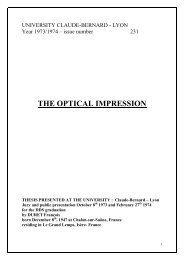english version(pg40to78) - Pr. François Duret
english version(pg40to78) - Pr. François Duret
english version(pg40to78) - Pr. François Duret
You also want an ePaper? Increase the reach of your titles
YUMPU automatically turns print PDFs into web optimized ePapers that Google loves.
F <strong>Duret</strong> and Coll. <strong>Pr</strong>incipes de fonctionnement et applications techniques de l’empreinte optique dans l’exercice de cabinet<br />
(traduction Anglaise)<br />
Page 88<br />
[equation]<br />
As we have noted earlier all the values {X, Y, Z} of the tooth or the<br />
view of a side of the tooth must be identified and filtered. For that<br />
reason, a certain number of algorithms, some cabled, will enter into<br />
action in the FOURNIER 19 space or not. We suppress the hardware<br />
digitalisation noises, the speckles noises even more so important that<br />
the ripple of the light interferes with the micro surfaces of the flatness<br />
of the tooth, interference noises between the spatial frequency of the<br />
CCD and the RONCHI 20 weft used and all the system noises. The<br />
filtering techniques are complex and go beyond the framework of this<br />
study. We will simply say that each of the constituting elements of the<br />
acquisition chain of the tooth’s image must be studied with regards to<br />
the whole set and the non respect of this rule can diminish or even<br />
render unusable the caught signal of the tooth’s shape (Fig. 19 to 22).<br />
Then, the skeletal algorithms will come. This passage is necessary for<br />
several reasons:<br />
- the implementation of the comparison process of interferograms<br />
- the reduction of the number of image points addressed to the<br />
software and central unit of shape management (CAM)<br />
- the discretion several teeth in the same image space.<br />
The whole of these “washed” coordinates will be addressed to the<br />
CAM software in a simple language such as the Fortran 77 so that the<br />
tooth can be reconstituted and worked on.<br />
At this stage, we get a part of what we can call today the optical<br />
impression of the tooth. It took a few seconds to the captor to record<br />
the image and to the algorithm to synthesise it into coordinates in a tri<br />
dimensional space. The view capture appears on a control screen for<br />
acceptance or rejection. This view enables the verification of the<br />
quality of the impression and also the work done inside the mouth of<br />
the patient. An over impression<br />
Les Cahiers de <strong>Pr</strong>othèse (50) pp 73 – 110, 1985



